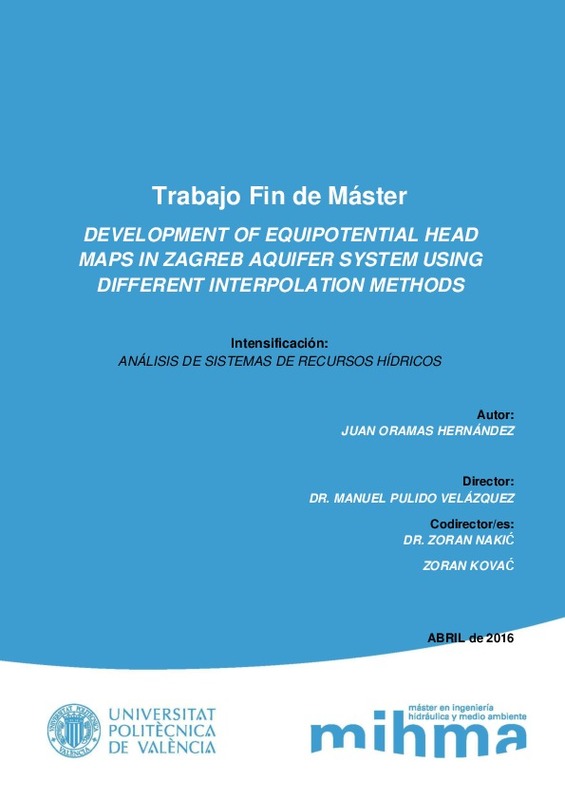|
Resumen:
|
[EN] The large and quickly development that the City of Zagreb has experienced during the last decades has caused an increment of the demanded of resources, between them, the water supplied. Thus the Zagreb Aquifer System, ...[+]
[EN] The large and quickly development that the City of Zagreb has experienced during the last decades has caused an increment of the demanded of resources, between them, the water supplied. Thus the Zagreb Aquifer System, as the only source of potable water of Zagreb, has experienced a decrease of the ground water levels generating changes in the operation of the system.
To analyze this decrement of levels is necessary to study the characteristics of the aquifer: geographic characteristics, geology, pedologic characteristics, hydrogeology, climatic and meteorological characteristics, the Sava River and ground water dependent ecosystems. Next, it was done the spatial interpolation of the aquifer levels using the software ArcGis through four methods: Inverse Distance Weight, Spline, Kriging and Natural Neighbor. The option and parameters of each one of those methods were studied and modified to check which one fits better to this system. The initial data used were the lowest and highest for 15 years with maximum and minimum daily and average monthly data.
Before to interpolate and due to the large amount of data, it was done a cluster of them, selecting those data which made a homogeny cloud of observation wells.
After the interpolation, it was made an accuracy study using Pearson-Spearman, Root Mean Squared Error and t-test comparing the initial data with the final results of each method. The goal of this study was to help to decide which method was the best one, but it did not work because the result of the four methods was very accurate. So that, the choice was decided through the plots that ArcGis gave, being the Natural Neighbor the method more accurate.
These maps obtained by the interpolation in the software were used for draw the four final maps of aquifer levels: maximum and minimum daily levels and maximum and minimum average monthly; correcting the local errors that the interpolation drew.
Moreover, some conclusions could be gotten. First of all, the very high hydraulic conductivity, become it in a very dynamic system, generating changes in the direction of the flow depending on the level aquifer and if daily or monthly data are used. Due to, it should be used different kinds of data depending on the scope of the study, because if this is not considered, the yielded results could be wrongs.
[-]
[ES] El gran y rápido crecimiento que ha experimentado la Ciudad de Zagreb durante las últimas decadas ha causado un incremento de la demanda de muchos de los recursos, entre ellos el abastecimiento de agua. Por tanto el ...[+]
[ES] El gran y rápido crecimiento que ha experimentado la Ciudad de Zagreb durante las últimas decadas ha causado un incremento de la demanda de muchos de los recursos, entre ellos el abastecimiento de agua. Por tanto el sistema acuífero de Zagreb, como única fuente de agua potable de la ciudad, ha experimentado una disminución de los niveles de agua subterránea, generando cambios en la operación del sistema.
Para analizar esta disminución de niveles es necesario estudiar las características del acuífero como las características geográficas, geología, características pedológicas, hidrogeología, características climáticas y meteorológicas, el Río Sava que es el principal factor que influencia al sistema y los ecosistemas dependientes del agua subterránea. A continuación se procedió a realizar una interpolación espacial de los niveles del acuífero utilizando el software ArcGis mediante cuatro métodos: Ponderación de Distancia Media (Inverse Distance Weight), Spline, Kriging y Vecino Natural (Natural Neighbor). De cada uno de estos métodos se han estudiado las opciones y parámetros a modificar para ver cuál se adapta mejor al sistema. Los datos de entrada utilizados en el estudio fueron los de los niveles más bajos y más altos de los últimos 15 años con datos máximos y mínimos diarios y medios mensuales.
Previamente a la interpolación y debido a la gran cantidad de datos iniciales, se ha realizado un ¿cluster¿ de los mismos, seleccionando aquéllos que se consideren necesarios hasta obtener una nube de observaciones homogénea a lo largo de toda la extensión del acuífero.
Tras la interpolación se realizó un estudio de precisión de los resultados respecto de los datos de entrada mediante Pearson-Spearman, Error Cuadrático Medio y el t-test para comparar los resultados obtenidos en los diferentes métodos de interpolación y así ayudar a decidir qué método se adapta mejor a este sistema. El resultado de este estudio no ayudó en la toma de la decisión ya que todos los resultados numéricos de todos los métodos tienen una gran precisión. Por tanto la decisión se tomó teniendo en cuenta los resultados gráficos obtenidos en forma de mapas a través de ArcGis, concluyendo que el método del Vecino Natural aporta resultados más precisos.
Con estos mapas obtenidos directamente de la interpolación en el software se dibujaron los cuatro mapas de niveles del acuífero correspondientes a los valores máximos y mínimos diarios y mensuales, corrigiendo los errores locales propios de la interpolación.
También, de la Tesis se puede concluir que la alta conductividad hidráulica del acuífero lo convierte en un sistema muy dinámico, produciendo grandes cambios en la dirección del flujo no sólo cuando éste se encuentra en niveles máximos o mínimos, sino también cuando se utilizan datos diarios o mensuales. Por ello debe tenerse en cuenta este hecho a la hora de decidirse por un tipo de dato u otro dependiendo del tipo de estudio que quiera realizarse.
[-]
|







